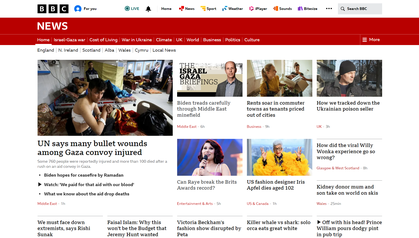Popular News Can Be Fun For Everyone
The Only Guide for Popular News
Table of ContentsPopular News Things To Know Before You Get ThisLittle Known Questions About Popular News.The Of Popular NewsThe Popular News PDFs
Age is likewise a factor in the way individuals watch the duty of social media. More youthful social media information customers are a lot more likely to say it has actually influenced their discovering right. About half of social media sites information consumers ages 18 to 29 (48%) claim information on social networks makes them better educated, contrasted with 37% of those 30 to 49, 28% of those 50 to 64, and 27% of those 65 and older.Journalists evaluate information values when establishing whether or not to cover an event or news. Perhaps the most vital element of newsworthiness is whether or not the information thing being communicated influences a news outlet's target market.
Research on a state's new tax code likely won't generate the exact same passion throughout state boundaries. Occasionally specialists can assist localize a larger national story that affects more than just a city or state.
If you are publishing newsworthy research, loophole in MarComm before the write-up being released to make sure that the pitch can stress the latest component of the tale: the publication of the research study. Occasions and statements that include prominent figures are more likely to create media insurance coverage. Gos to from national numbers usually call for months of prep work due to anticipated area passion.
Not known Facts About Popular News
Stories commonly involve some sort of dispute. Necessarily, these tales are almost constantly controversial to some extent. College staff and faculty are usually viewed as neutral experts. We can aid minimize possible reputational danger with these tales while also enhancing the probabilities of generating insurance coverage. While most of the above news values are interwoven, human rate of interest stories usually stand apart.
Human rate of interest aspects can add news value to various other tales that may appear to be lacking in the other worths. The uniqueness or anomaly of a situation can assist affect whether a news outlet is likely to cover a story. While this is not an exhaustive list, examining to see if your story or occasion has these qualities prior to contacting us will assist you determine which elements hold one of the most news worth.
The study discovers that a little even more than fifty percent of all U.S. adults subscribe to news in some formand roughly fifty percent of those to a paper. And in contrast to the concept that youths will certainly not spend for information since information online is cost-free, virtually 4 in 10 grownups under age 35 are paying for news.
There is additionally substantial proof that even more consumers could begin to pay for information in the futureif publishers can recognize them and offer them well. Half of those who do not spend for news proactively choose read the full info here news and look like customers in different ways. And almost 2 in 10 of those who do not sign up for news currently indicate they are inclined to begin to pay in the future.
Popular News Things To Know Before You Get This

Individuals are attracted to news generally for 2 reasons above others: A wish to be educated citizens (paper subscribers particularly are highly encouraged by this) and due to the fact that the magazine they register for excels at covering specific subjects concerning which those clients especially care - Popular News. While there are a host of reasons, the No
Even more than 4 in 10 additionally point out the reality that family and friends sign up for the same item. Greater than a 3rd of individuals state they initially subscribed in reaction to a discount rate or promotion. In print, individuals additionally are moved greatly to sign up for obtain promo codes that conserve them cash, something that has untapped implications in electronic.

The 7-Minute Rule for Popular News
We asked everyone that told us they have a regular complimentary source of information exactly how most likely they would certainly be to pay for it. Even more than a quarter (26 percent) say they would certainly be at least somewhat most likely to begin paying for itand 10 percent are very or very likely. These most likely payers have a tendency to be news applicants, and they also often tend to be people More hints that already spend for a news registration along with the resource they follow free of charge.
Of those who do pay, 54 percent register for newspapers in print or electronically, which stands for 29 percent of Americans in general. The majority of them buy a print publication in addition to their newspaper and spend for 2 to four information resources in total, some a lot more. And while 53 percent are long-time subscribers (5+ years), even more than a quarter (27 percent) have actually purchased their newspaper registration within the past year.
